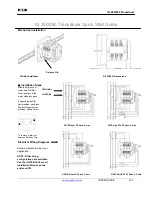
3 Board
M900/M1800 BTS3X Series Base Transceiver Station
Hardware Description Manual
3-16
Huawei Technologies Proprietary
Issue 01 (2006-11-18)
DIP
Switch
DIP Bit
Function
Setting Method
S2 4 CBUS1,
CBUS2 pull
up/down
resistor
ON indicates that the pull up/down resistor
exists;
Bit 1 and 2 are for CBUS1. On the primary
cabinet in the primary cabinet group, they are set
ON, and on other cabinets, they are set OFF;
Bit 3 and 4 are for CBUS2. On the primary
cabinets, they are set ON, and on other cabinets,
they are set OFF.
S3 4 DBUS1,
DBUS2 pull
up/down
resistor
ON indicates that the pull up/down resistor
exists;
Bit 1 and 2 are for CBUS1;
Bit 3 and 4 are for CBUS2. On the primary
cabinets, they are set ON, and on other cabinets,
they are set OFF.
S4 4 CBUS3
pull
up/down
resistor
ON indicates that the pull up/down resistor
exists.
On the primary cabinets, they are set ON, and on
other cabinets, they are set OFF.
S5 4 Indicates
product feature
number:
BTS30: 0000
BTS312: 0001
BTS30A: 0010
OFF: 1; ON: 0
The binary bits are used to indicate the cabinet
number: Bit 1 is MSB (high bit); Bit 4 is LSB
(low bit);
For the BTS312, the DIP switch setting is as
follows:
!
Bit 1: ON
!
Bit 2: ON
!
Bit 3: ON
!
Bit 4: OFF
3.5 ECDU
3.5.1 Functions
Functions and external ports (including dimensions) of the ECDU are the same as those of the
CDU. It implements the combination of transmitted signals, the dividing of received signals,
and the duplex function. The only difference between the ECDU and the CDU is that a single
port of the ECDU supports a maximum of 100 W input power.
3.5.2 Structure and Principle
The ECDU has multiple panel types, but the structure and the principle of the ECDU are the
same in any cases. See
















































